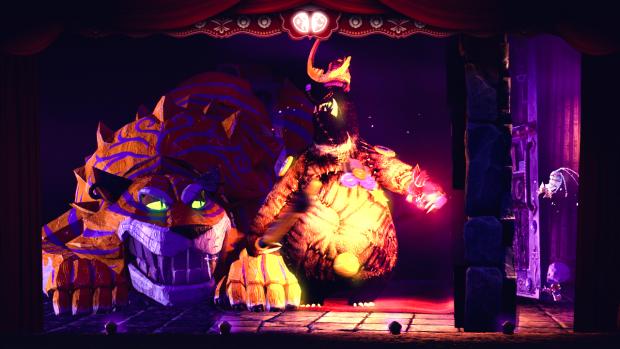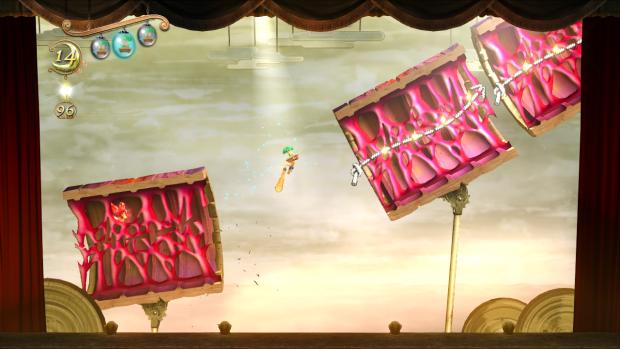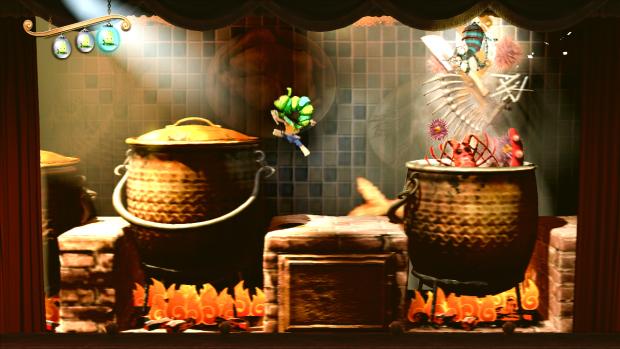Puppeteer Preview – Master of Puppets
It’s easy to get caught up in over-the-top hyperbole these days. Video games are treated as Hollywood blockbusters, and many have a budget to match. That said, Puppeteer is possibly one of the best looking games I’ve ever had the pleasure to play. How’s that for hype?
It’s not good looking in the way that a Battlefield 4 is good looking, there’s little to no realism involved, controlling a Puppet as you do, and involving yourself in a theatre that contains objects and people entirely made of papercraft. It looks so good, but when you involve a 3DTV, it actually becomes mind-blowing. In fact, Puppeteer does (at times) feel as though it has been designed with 3DTVs in mind, because it truly (and clichés be damned) comes alive in this mode. The moments where the wonderful story is told will be heightened by characters literally coming out of the screen at you, before swooping back in to their rightful place. The ever changing playground that switches from scene to scene is so well designed and implemented, it’s hard not to gasp along with the virtual theatre audience.
But I’m not going to even pretend that most people have 3DTVs, and whilst you would truly be missing out with this one game, the visuals are absolutely glorious even with a non-3DTV. Whether you are cutting your way out of a paper-made Snake that doubles as a boss fight, or using your magic scissors to climb a giant tiger’s legs to cut off his moon-powered tooth to defeat him, there’s barely a moment that allows you to pick your jaw from the floor.

It’s not just the visuals that shine though, the audio is absolutely spectacular. Surround sound reveals the virtual audience cheering you on, with “wow” reactions when it seems right to do so. The voice acting is nigh-on perfect, too, and every character is played to perfection, be it the aforementioned tiger (think Sheer Khan, but slightly camper) and snake (every “S” is hissed), or even your first guide to the world, who just happens to be a cat and therefore pronounces every possible word with a “meow” twist. Just think about that for a moment – a flying cat that says “meown” instead of “moon”. It’s brilliant. Truly, utterly brilliant. The whole play is narrated beautifully, even breaking the fourth wall at times, interacting with the characters that surround you, Kutaro.
Which leads us onto the mechanics and story of the actual game, of course. Kutaro, an earth-boy who has been turned into a puppet by the moon-bear king (the evil ruler) and has had his head removed. You can find multiple different heads (about 15+ per episode, over lots of episodes = lots of heads) but they all act in a similar way to Mario getting a mushroom. You can have three heads at any given time, and if you are hit by an enemy, you’ll lose the head you were wearing. If you’re quick enough, you can grab the head back and be none the worse for wear, but if you’re too slow, you’ll lose that head and be down to two. Heads have a secondary use, too, as there are hidden bonus areas that require the skill of a certain head to unlock. For example, there might be a faded banana-head symbol, and therefore, if you have that head you can put it on and reveal the bonus level. It sounds confusing, but it’s very simple and provides even more character to a game bulging at the seams with it.

Early on, you’ll be tasked with finding the moon-bear king’s magical scissors: Calibrus. These scissors allow for Kutaro to navigate in a different way. In a similar manner to Kirby’s Epic Yarn, Kutaro can attach himself to a seam and hammer the square button to travel along using the scissors – the faster you hammer square, the quicker he’ll move.
Tight controls are the order of the day, and I’m slightly proud of myself that this is the first time I’m mentioning LittleBigPlanet. At first glance, you’ll definitely feel a strong hint of LBP about Puppeteer, but further exploration of the mechanics will soon make you realise that, although yes, it does look slightly LBP-ish, the controls (specifically the jumping) are much tighter than its platform-buddy. In fact, the only issue I had at all with the controls were using jump pads, which seemed (at times) hit or miss and caused a few frustrating deaths. Checkpoints are pretty generous, however, so it’s never a big deal – but it’s definitely something that could be tightened up between now and the game’s final release.
As you explore the environment, certain background items will hold either new heads, or magic pieces that you can collect. Every time you get 100 of these star-type pieces, you will get another chance, should you lose all your heads and die. Exploring the backgrounds is done with a secondary character (initially the moon-cat, Ying-Yang). Moving the right stick will move Ying-Yang (and later, his replacement) around, and if you find an item you think is hiding something, you just have to hit R2 to examine it.

The levels are split into acts and curtains (chapters and levels – 3 curtains per act), and the multitude of creative boss-fights (some gave me Shadow of Colossus vibes) and generally unique looking levels, combined with tight platforming controls should be enough for any gamer, but Sony Japan have even included fairy tales that are unlocked after each act is completed. Relevant to the plot, fleshing out details and backstory of the players, these are gorgeous, partially animated books that are narrated by the same person narrating the game itself.
Maybe I’m the only one who has been surprised by Puppeteer, but this is a game that has come completely out of left-field, utterly blown me away, and left me wondering why other games can’t be as creative, as gorgeous, as clever and inclusive as this one. Puppeteer appears to appeal to every demographic, despite moments of darkness here and there, the visual style alone elevates this one from casual passing interest, to a must-buy. Throw in the excellent controls, ideas that feel fresh and new, and by now you should be getting the picture: this is one to watch very, very closely. With this generation drawing to a close, it’s incredible that Sony just keep bringing us these high-quality games, it really is.




